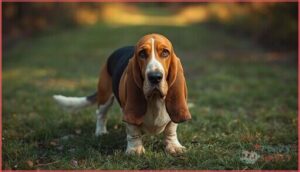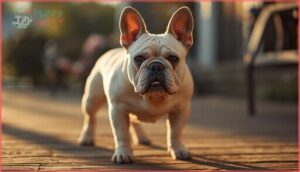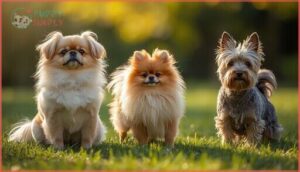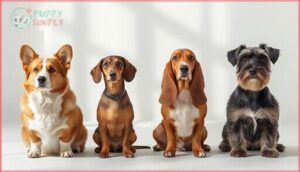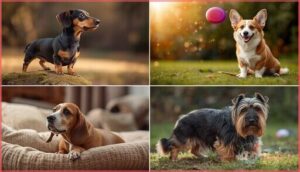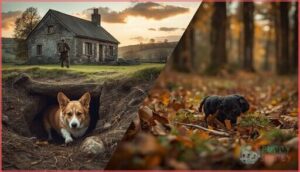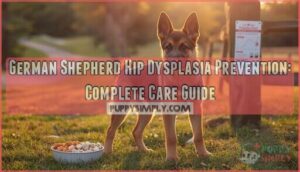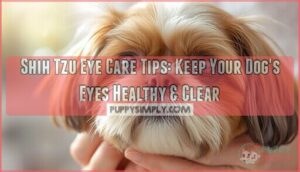This site is supported by our readers. We may earn a commission, at no cost to you, if you purchase through links.
Dogs with small legs pack striking personalities into compact frames. These breeds weren’t designed this way by accident—their short stature gave them real advantages in the work they were bred to do. Corgis stayed low to dodge cattle hooves while herding, and Dachshunds could squeeze into underground burrows to flush out badgers.
Today, these same traits that made them excellent workers also make them appealing companions, though their unique body structure comes with specific care requirements. From the fearless Dachshund to the affectionate Corgi, each short-legged breed brings its own temperament and health considerations you’ll want to understand before bringing one home.
Table Of Contents
Key Takeaways
- Short-legged breeds like Corgis and Dachshunds were purposefully bred with their compact stature to excel at specific jobs—herding cattle close to the ground or hunting prey in underground burrows—and their unique body structure comes from a genetic mutation called chondrodysplasia that affects cartilage development.
- These breeds face significantly higher risks of serious health problems, particularly intervertebral disc disease (IVDD) and joint issues, with Dachshunds showing a 19-24% lifetime risk of spinal disease compared to just 2% in longer-legged breeds, making weight management and preventive care absolutely critical.
- Daily care for short-legged dogs requires modified exercise routines that avoid high-impact activities, with 30-60 minutes of low-impact movement split into shorter sessions to protect their vulnerable spines and joints from unnecessary strain.
- Proper weight management isn’t just about appearance—it’s essential for preventing the joint pain and spinal complications these breeds are predisposed to, requiring careful calorie control, high-protein diets, and joint supplements to maintain their mobility and quality of life.
Popular Dog Breeds With Small Legs
You’ll find short-legged dog breeds in all shapes and sizes, from herding champs to apartment-friendly companions. Each breed brings its own personality, quirks, and care needs to the table.
Let’s look at some of the most popular dogs with those adorably short legs.
Pembroke and Cardigan Welsh Corgis
When you think of herding dog breeds, Pembroke Welsh Corgis and Cardigan Welsh Corgis probably come to mind. These short-legged dog breeds pack serious muscle into compact frames. Here’s how they differ:
- Pembrokes stand 10-12 inches tall, weigh 27-30 pounds, and often have docked tails
- Cardigans reach similar heights but are bulkier at 38 pounds with full tails
- Coat colors vary more in Cardigans, including brindle and blue merle patterns
Their herding heritage shines through in intelligence and loyalty. Both breeds are prone to certain health issues, so regular vet check-ups are essential.
Dachshunds
While Corgis dominate herding circles, Dachshunds reign in the hunting world. These badger hounds rank 6th in breed popularity, thanks to their bold personalities and portable size. Standard Dachshunds weigh 16-32 pounds, standing just 8-9 inches tall, with smooth, wirehaired, or longhaired coat variations. Dachshunds were originally bred to be German badger dogs, showcasing their historical purpose.
| Trait | Standard | Miniature |
|---|---|---|
| Weight | 16-32 lbs | Under 11 lbs |
| Height | 8-9 inches | 5-6 inches |
| IVDD Risk | 15.7% prevalence | Slightly lower |
Their stubborn, loyal temperament reflects their hunting heritage. Unfortunately, they face 10-12 times higher IVDD risk than other dog breeds, making proper dog care and weight management critical for their health.
Basset Hounds
Where Dachshunds chase prey underground, Basset Hounds track it by scent across open terrain. These hound dog breeds stand 11-15 inches tall but weigh a hefty 40-65 pounds, thanks to their heavy-boned build. You’ll recognize their droopy ears, soulful eyes, and unique vocalizations instantly.
Despite their calm demeanor, scent tracking instincts dominate their behavior. Weight management is critical, as obesity worsens joint problems and back issues common in short-legged dog breeds.
French Bulldogs
Unlike laid-back Bassets, French Bulldogs pack big personalities into stout, 16-28 pound frames. You’ll love their bat ears and playful nature, but brachycephalic syndrome causes breathing struggles in these short-legged dog breeds.
Their popularity surge has raised ethical breeding concerns, as poor practices worsen dog health issues.
Daily facial fold cleaning covers grooming needs, while weight management protects their already vulnerable joints and airways.
Cairn Terriers
These scrappy Scottish hunters from the Highlands stand 10-12 inches tall and weigh just 13-17 pounds, making them perfect for rocky terrain pursuits. You’ll appreciate their foxy expression and weather-resistant double coat, which comes in various shades and often changes color over time.
- They’re intelligent but stubborn, requiring consistent training from day one
- Weekly brushing prevents matting in their wiry, weather-resistant coat
- Their alert, vocal nature makes them excellent watchdogs despite their size
- Regular moderate exercise keeps joints healthy without risking injury
Pekingese, Pomeranians, and Scottish Terriers
Three distinct dog breeds with short legs offer unique personalities and care requirements.
Pekingese bring royal charm with their stocky 7-14 pound frames and flowing coats, though they face elevated IVDD risks.
Pomeranians weigh less but demand frequent grooming and monitoring for patellar luxation.
Scottish Terriers, the sturdiest at 18-22 pounds, display independent temperaments and require regular health screening for breed-specific cancers and urinary conditions.
Physical Traits of Short-Legged Dogs
Short-legged dogs share more than just their low-to-the-ground stance. Their physical traits vary widely, from body shape and coat texture to the unique features that make each breed stand out.
Let’s look at what sets these compact companions apart.
Body Proportions and Limb Length
Short-legged dogs have unique body proportions that set them apart. Your Corgi or Basset Hound has limb length variation caused by chondrodysplasia, a genetic trait affecting cartilage development.
These breeds show body ratio specifics with length-to-height values often exceeding 1.5, meaning their long bodies contrast sharply with shortened legs. Muscular adaptations in their pelvic limbs help compensate for altered mechanics, while morphological measurements and breed standard conformity guarantee you’re getting authentic canine dwarfism characteristics.
Coat Types and Colors
Your short-legged pup’s coat genetics determine everything from texture to hue, affecting grooming needs and breed standards. Dog breeds and coat variations range widely, with color patterns influenced by specific genes.
- Smooth coats (Dachshunds, French Bulldogs) need minimal brushing
- Double coats (Corgis) shed seasonally, especially spring
- Common colors include black, fawn, red, cream
- Patterns like brindle, merle, sable appear frequently
- Rare colors (blue, lilac) emerge through selective breeding
Distinctive Features by Breed
You’ll spot each short-legged breed by their signature look—think Corgi Bobtails, Dachshund Elongation, or Basset Droop. These dog breed physical traits define Short-Legged Dog Breeds instantly.
Dog breed characteristics help you recognize these companions anywhere.
| Breed Feature | Key Trait |
|---|---|
| Frenchie Ears | Bat-shaped, naturally upright |
| Corgi Bobtails | Natural or docked tails |
| Basset Droop | Loose skin, velvety ears |
| Terrier Tenacity | Strong jaws, thick paw pads |
Temperaments and Personalities
Short legs don’t dictate personality, but they often come with some pretty distinct traits. You’ll find that these breeds range from fearless hunters to gentle couch companions, each shaped by what they were originally bred to do.
Let’s look at what makes these dogs tick, from their playful sides to their working instincts and how they fit into your home.
Playful and Affectionate Breeds
You’ll find that cardigan Welsh corgis and Boston terriers rank high in breed playfulness, displaying affectionate behaviors that make them ideal family-friendly dog breeds. Bichon frises and miniature schnauzers also demonstrate this affectionate breed temperament.
These short-legged dog breeds thrive on interaction, with activity statistics showing they need daily mental and physical engagement. Their playful nature and dog breed personalities adapt well to various households, explaining current ownership trends.
Herding and Hunting Instincts
While playfulness defines many short-legged breeds, their herding instinct and hunting dogs’ drives run deep. Pembroke corgis still nip heels and circle, using herding techniques bred for cattle work. Dachshunds and basset hounds retain hunting styles like scent tracking and digging.
These breed-specific behaviors need contemporary outlets—agility courses, puzzle toys, or herding trials—to keep your dog mentally satisfied and prevent unwanted nipping or digging at home.
Adaptability to Families and Urban Living
Many short-legged breeds make excellent family pets and adapt well to urban living. French Bulldogs and Pembroke Welsh Corgis handle apartment life with proper urban exercise routines and family socialization.
Their breed temperament suits children when trained consistently, though health concerns like IVDD require careful activity management. These loyal companions thrive in smaller living spaces if you provide mental stimulation and maintain a healthy weight to protect their joints.
Origins and History of Small-Legged Breeds
Short legs in dogs didn’t happen by accident. People bred these dogs for specific jobs, and their compact build gave them real advantages in the field.
Let’s look at how different breeds developed their short stature and what work they were meant to do.
Breeding Purposes (Herding, Hunting, Companionship)
While short legs might seem like a quirk, you’ll discover they’re actually purpose-built adaptations. Corgis developed herding adaptations like low stature to dodge livestock kicks while nipping at heels. Dachshunds showcased hunting instincts, their elongated bodies perfect for burrowing after badgers.
French Bulldogs and Pekingese were bred purely for companion traits, prioritizing affectionate temperaments over work. These family-friendly dog breeds evolved as loyal companions, though breed health challenges sometimes accompanied their specialized roles.
Evolution of Short Legs in Dogs
Your dog’s short legs didn’t happen by accident. Scientists traced this trait to an FGF4 duplication—a genetic mutation that occurred thousands of years ago and spread through selective breeding.
This functional adaptation gave breeds like dachshunds and corgis advantages in hunting and herding. The mutation causes chondrodysplasia, altering cartilage development.
Understanding these genetic variations helps explain why short-legged dog breeds share similar body proportions despite their diverse origins.
Notable Historical Roles by Breed
Throughout history, short-legged breeds played important roles that shaped their temperaments today. Pembroke Welsh Corgis herded cattle in Wales since AD 1107, nipping at hooves while dodging kicks. Dachshunds hunted badgers in German burrows, their fearless personalities still evident.
Basset Hounds tracked rabbits with their powerful noses, while French Bulldogs shifted from lace workers’ companions to fashionable city pets by the early 1900s.
Health and Care for Short-Legged Dogs
Owning a short-legged dog comes with unique responsibilities, especially regarding their health. These breeds face specific challenges related to their body structure, from spinal issues to joint strain.
Let’s walk through what you need to know to keep your low-rider companion healthy and comfortable.
Common Health Issues (IVDD, Joint Problems)
When it comes to short-legged breeds, their adorable stature comes with real health trade-offs. The genetic condition responsible for those stubby legs, called chondrodysplasia, also sets the stage for serious dog health issues down the road.
Short-legged breeds trade adorable stature for serious health risks rooted in the same genetic condition that creates their stubby legs
Here’s what you need to know about common dog breeds and health problems:
- IVDD Incidence is alarmingly high – Dachshunds face a 19-24% lifetime risk of intervertebral disc disease, while Basset Hounds show a 36% presentation rate compared to just 2% in longer-legged breeds.
- Genetic Predisposition drives joint degeneration – Pembroke Welsh Corgis experience hip dysplasia in about 20% of cases, with osteoarthritis affecting nearly 7%, and French Bulldogs commonly develop patellar luxation.
- Pain Management and Mobility Solutions become essential – Early veterinary intervention, weight control, physical therapy, and in severe cases, surgery can greatly improve your dog’s quality of life and prognosis.
The bottom line? Your short-legged companion’s unique build requires proactive monitoring for spinal and joint issues throughout their lifetime.
Exercise and Mobility Needs
Getting your short-legged pup moving safely requires careful thought. Suitable exercises matter tremendously—avoid jogging or sudden sprints that compromise spine alignment. Exercise duration should hit 30 to 60 minutes daily, but split it into shorter sessions to prevent overexertion. Low-impact exercise like gentle walks on soft surfaces protects those vulnerable joints and spines from unnecessary strain.
| Exercise Type | Why It Works |
|---|---|
| Controlled walking | Maintains muscle tone without spinal stress |
| Mental stimulation games | Fulfills energy needs, reduces joint impact |
| Assisted mobility aids | Aids dogs with existing mobility challenges |
Safety considerations include monitoring weather, hydration, and your dog’s breathing. The health impact is clear: regular, appropriate activity prevents obesity-related complications while strengthening core muscles that promote proper movement. Watch for signs like heavy panting or trembling, which signal it’s time to dial things back.
Grooming and Daily Care
Your short-legged companion’s grooming needs deserve regular attention to keep them healthy and comfortable. Coat brushing frequency depends on hair type—long-haired breeds need daily brushing, while short-haired pups can go weekly. Nail trimming every 2–4 weeks prevents gait issues, and weekly ear cleaning reduces infection risk in floppy-eared breeds.
- Bathe your dog every 4–6 weeks to maintain skin health without stripping natural oils
- Trim paw pad hair regularly to prevent debris buildup and matting
- Check nails monthly, even when overgrowth isn’t obvious
Weight and Diet Management
Maintaining a healthy weight in your short-legged dog is crucial for more than just appearance—it’s essential for preventing joint pain and spinal issues. Calorie requirements vary by breed, making veterinary monitoring vital for adjusting portions as needed. Obesity risks are significantly higher in these breeds, emphasizing the importance of portion control for overall dog health.
| Management Area | Recommendation | Frequency |
|---|---|---|
| Calorie intake | 1.6× RER for maintenance | Daily monitoring |
| Exercise intensity | Low-impact activities | 20–30 min/day |
| Joint supplements | Glucosamine, chondroitin | Daily with meals |
| Weight checks | Track progress, adjust diet | Every 1–3 months |
Feed high-protein, low-fat foods to meet your dog’s breed-specific care needs. Limit treats to 10% of daily calories, and incorporate joint supplements to safeguard their vulnerable legs.
Frequently Asked Questions (FAQs)
Are there any specific dietary considerations for short-legged dogs?
You can’t just feed them like any other pup—short-legged dogs need calorie-dense diets with high-quality protein sources, joint support supplements, and controlled feeding frequency to maintain a healthy weight and prevent mobility issues.
Are short-legged dogs more prone to back injuries?
Yes, shortlegged dog breeds face higher IVDD prevalence and biomechanical strain due to their body proportions. Common injury types include disc herniation and ligament conditions.
Preventive strategies like weight management can reduce these dog health problems considerably.
Can short-legged dogs swim safely and comfortably?
Most short-legged dog breeds struggle with swimming ability due to drowning risks from poor buoyancy and rapid fatigue.
Safety measures like life jackets, shallow water, constant supervision, and gradual training methods can help protect these breeds.
What causes the short leg trait genetically?
A functional retrogene insertion of FGF4 on dog chromosomes causes limb shortening in breeds like Corgis and Dachshunds.
This autosomal dominant mutation disrupts normal bone growth, creating the characteristic short-legged appearance.
How much does treating IVDD typically cost?
IVDD surgery cost ranges from $5,000 to $12,000 total, including diagnostic imaging fees. Severity impacts costs greatly. Insurance coverage helps offset expenses, while post-op expenses add $500 to $1,000 for recovery care.
Conclusion
Understanding dogs with small legs means recognizing that their compact build isn’t just adorable—it’s the most carefully engineered feature in canine history.
These breeds thrive when you respect their physical limits, maintain their ideal weight, and provide environments that protect their backs and joints.
You’re not just choosing a pet with a unique silhouette; you’re committing to specialized care that honors their working heritage and keeps them comfortable for years to come.




